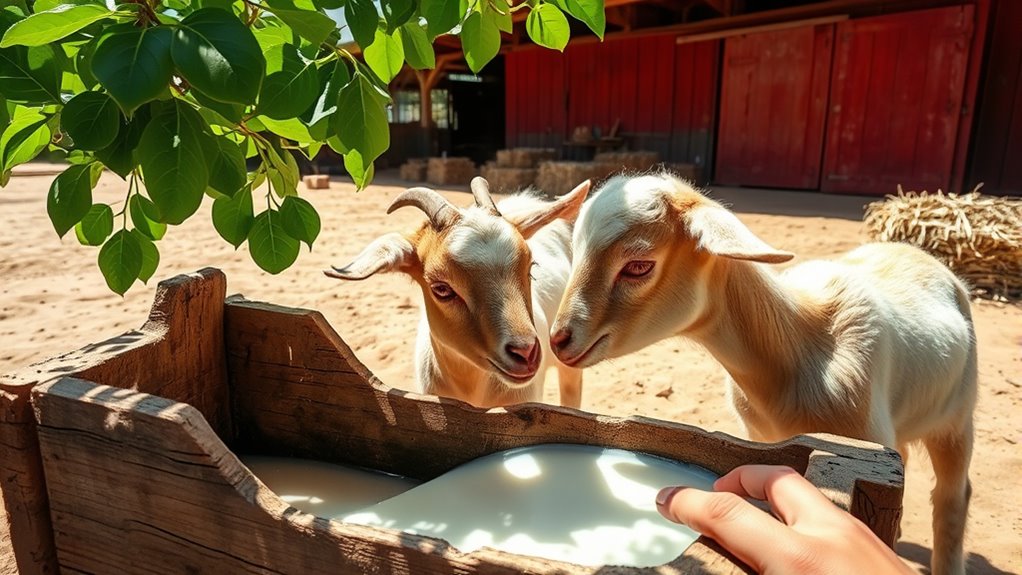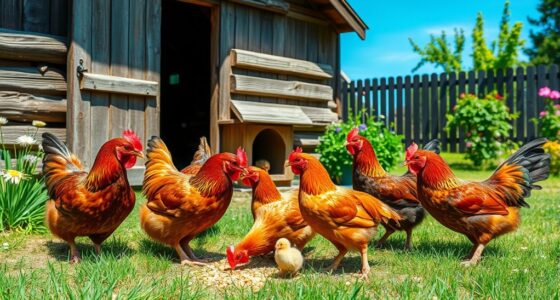To raise goats for milk successfully, start by choosing a dairy breed like Saanen, Toggenburg, or Alpine that suits your climate and goals. Make certain they have a balanced diet with plenty of clean water, quality hay, grains, and mineral supplements tailored for lactating goats. Provide proper shelter, routine health checks, and vaccinations to keep your herd healthy. Paying attention to nutrition, environment, and herd management helps maximize milk production; exploring these tips further will set you on the right path.
Key Takeaways
- Choose proven dairy breeds like Saanen, Toggenburg, or Alpine for higher milk production.
- Provide a balanced diet with quality hay, grains, minerals, and ample clean water daily.
- Ensure proper shelter and protection from weather and predators to keep goats healthy.
- Regular health checks, vaccinations, and parasite control prevent illnesses and support productivity.
- Monitor body condition and adjust nutrition for pregnant and lactating does to maximize milk yield.

Raising goats for milk can be a rewarding way to provide fresh, nutritious dairy products for your household. To do this successfully, you need to understand the basics of goat nutrition and select the right dairy goat breeds. Proper nutrition is the foundation of healthy, productive goats, so you’ll want to focus on providing a balanced diet that meets their specific needs. Goats are browsers, meaning they prefer a varied diet that includes grasses, leaves, and shrubs, but in a farm setting, you’ll typically supplement their grazing with quality hay, grains, and mineral supplements. Guaranteeing they receive adequate protein, vitamins, and minerals is key to maintaining their health and maximizing milk production. Pay close attention to their body condition and adjust feed as needed to keep them in ideal health.
Raising healthy, productive goats starts with balanced nutrition and proper care.
When it comes to selecting dairy goat breeds, some are better suited for milk production than others. Popular breeds like Saanen, Toggenburg, and Alpine are known for their high milk yields and calm temperaments, making them ideal choices for beginners. These breeds tend to produce larger quantities of milk that are high in butterfat and protein, which are desirable traits for dairy purposes. Choosing the right breed depends on your climate, space, and milk usage goals, but starting with well-known dairy breeds increases your chances of success from the beginning.
You also need to assure your goats get consistent, clean water daily, as hydration directly affects milk production. Proper housing that protects them from extreme weather and predators is essential, and regular health checks will catch issues early. Routine vaccinations and parasite control should be part of your management plan to keep your goats healthy and productive. Additionally, understanding relationships in herd management can help prevent issues like stress and illness that impact milk yield.
Managing your goats’ nutrition involves more than just feeding; it requires monitoring their overall health and adjusting their diet as they grow, breed, or produce milk. For example, pregnant and lactating does need additional nutrients to support milk yield and their own health. Incorporate high-quality feeds, and consider supplementing with minerals formulated specifically for goats. Remember, a well-nourished goat is a happy, productive goat.
Starting with the right dairy goat breeds and prioritizing good goat nutrition sets a solid foundation for your milk-raising journey. With attention to their dietary needs, breed selection, and overall care, you’ll find that raising goats for milk can become a fulfilling and sustainable part of your homestead. As you gain experience, you’ll better understand how to optimize their diet and manage your herd for consistent, high-quality milk production.
Frequently Asked Questions
How Often Should I Milk My Goats?
You should establish a consistent milking schedule, typically twice a day, to keep your goats comfortable and maintain udder health. Regular milking prevents infections like mastitis and encourages steady milk production. Keep an eye on each goat’s udder for swelling or discomfort, and avoid over-milking. By sticking to a routine and monitoring udder health, you’ll guarantee your goats stay healthy and productive, making your dairy venture successful.
What Are the Common Health Issues in Dairy Goats?
You should watch out for common health issues like mastitis, parasites, and nutritional deficiencies. Proper goat nutrition is vital; guarantee they get a balanced diet rich in minerals and vitamins. Regular parasite control helps prevent infestations that can cause anemia or weight loss. Keep an eye on their udder health and overall behavior. Early detection and routine health checks keep your dairy goats healthy, productive, and happy.
How Do I Choose the Right Goat Breed for Milking?
When selecting dairy goats, focus on goat breed characteristics like milk production, temperament, and adaptability to your environment. You want a breed that suits your climate, space, and personal preferences, whether it’s high milk yield or ease of handling. Research different breeds, visit local farms if possible, and consider your goals. Choosing the right goat breed guarantees you enjoy healthy, productive dairy goats that fit your lifestyle.
What Is the Best Way to Store Goat Milk?
To store goat milk properly, focus on milk storage and refrigeration techniques. Immediately refrigerate fresh milk in clean, airtight containers to prevent spoilage. Keep the refrigerator at around 39°F (4°C) and avoid overloading it. Use the milk within 7-10 days for freshness. Regularly clean your storage containers, and if you need longer storage, consider freezing the milk in suitable containers, leaving space for expansion.
How Can I Increase Milk Production Naturally?
To naturally increase your goat’s milk production, focus on maintaining a consistent milking schedule, which keeps her producing steadily. You can also try herbal supplements like fenugreek or blessed thistle, known to boost milk yield. Make sure she’s well-fed with high-quality forage and plenty of fresh water. Regularly handling her gently and providing a stress-free environment further encourages increased milk production.
Conclusion
Now that you know the basics, you’re on your way to becoming a goat-milking master—your small farm could produce enough milk to rival a dairy factory! With patience, care, and a little bit of know-how, you’ll turn these adorable animals into reliable milk producers. Remember, every morning’s routine brings you closer to fresh, delicious milk straight from your goats. So get started—you’ve got what it takes to make your milking dreams come true!










